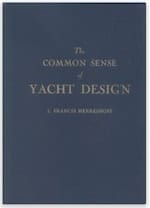Common Sense of Yacht Design, by L. Francis Herreshoff
Way, way more than the title implies, its two volumes cover yachting history, boating philosophy, and has been for me about the best overall treatise about boats I’ve ever read—and reread, and reread. And true to its title, there’s a lot about designing good boats.
The Rudder magazine
Thmas Fleming Day, or “the old man” as he called himself, was a sailor’s sailor besides being an opinionated magazine editor and author. During the 1940s and ‘50s, Boris Laurer Leonardi took over as editor and encouraged contributions from the likes of Hervey Garrett Smith, Bill Garden, and L. Francis Herreshoff. Good, timeless stuff!
. . . sign up to the right to get immediate access to this full post,
plus you'll get 10 of our best videos for free.
Get Free Videos& Learn More Join Now!!for Full Access Members Sign In



David Tew says:
Maynard, Steve, et al: Thanks for the flip-book version of LFH’s ‘Common Sense’ and your Boat Plans at Mystic Seaport! The format, readability and search capability are great. If you ever have the time or energy to scan and post favorite selections from old Rudder Magazines that would be excellent. They are rare enough and have such small type that the tool you’ve picked would be very useful for them, not to mention entertaining.
Richard W. Jacks says:
For those who enjoyed “Between Wind and Water” try Gerald Warner braces’s 1957 novel “The World of Carrick’s Cove”. You won’t be dissapointed.
David Corey says:
On Maynard’s advice, I found a used copy of the book by Gerald Warner Brace. Brace was a yacht designer, sailor, novelist and English professor. Between Wind and Water, written in 1966 when Brace was 65, is intended almost as a eulogy, of Maine and a way of life that he felt was passing. It is eloquent in its descriptions of boats, of weather, of fog, of sailing, of islands and bays, and of people. His writing has a crispness and rhythm, almost like the movement of a boat. Here is one passage, from the chapter on weather:
“But then comes June—and for five months the Maine weather is full of all the charm and surprise of a good drama: in fog and sun, heat and chill, foul and fair, it is a continuous adventure, with scenes of surpassing beauty succeeding one another from icy freshness of sunrise to the last dark flames of sunset. In foggy times your world turns mysterious, strange distant sounds haunt the air, you withdraw into yourself in secrecy; in storms you share the old legends of the sea and remember the exploits of brave seamen; in fair weather you rejoice in the flashing brightness of sea and land, and you push off once again on your never-ending quest for adventure among the islands.”
Brace talks especially about the people, about the residents and the summer people. He describes the traditional Maine stock—taciturn, independent, resourceful, resilient and generous—and mourns the passing of a people and a way of life. But 50 years later, I think they are still there, at least among the boat builders I have talked to, who know their craft and can build boats beautiful and strong without brag, who know what makes a boat fast and seaworthy, and why they are built a certain way. People, for instance, like Maynard Bray.